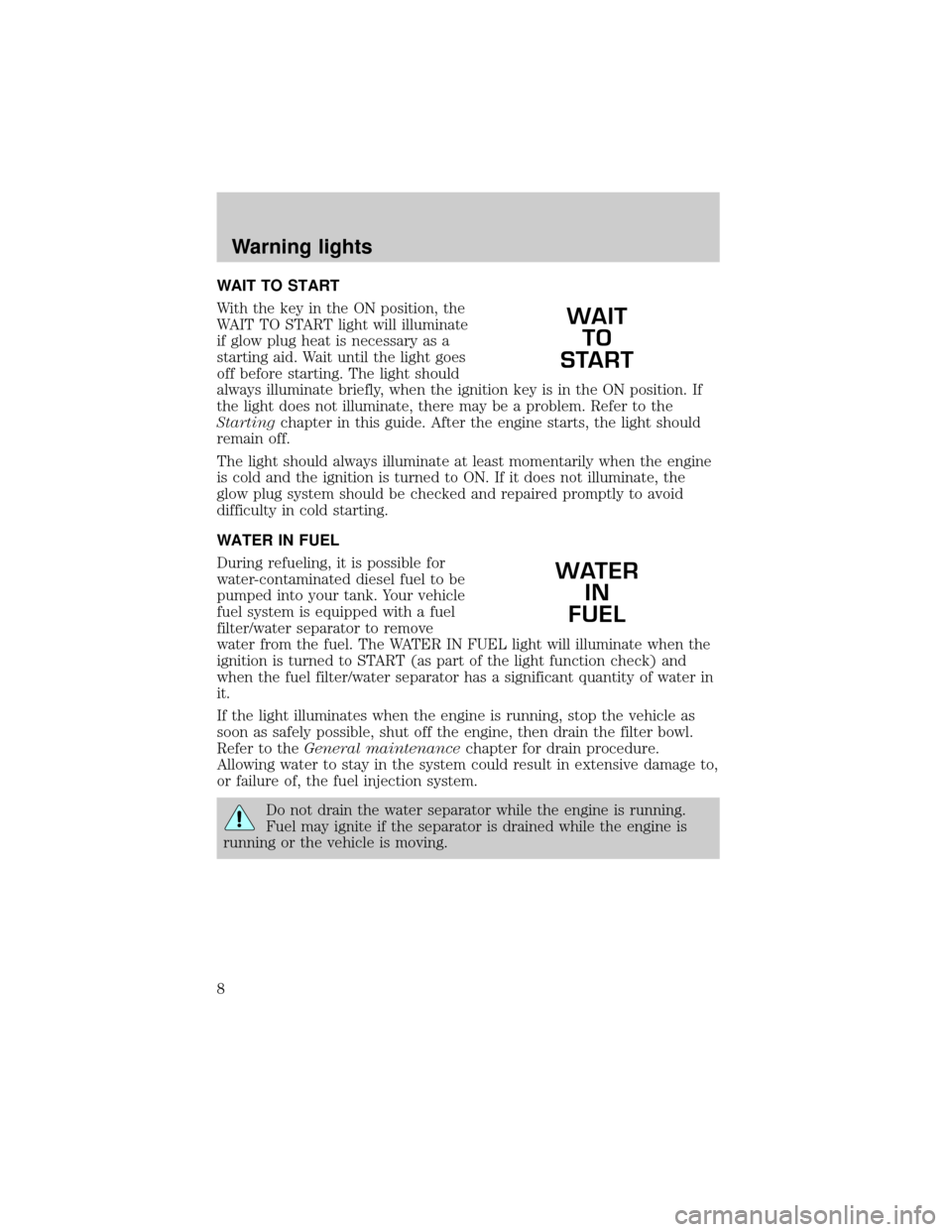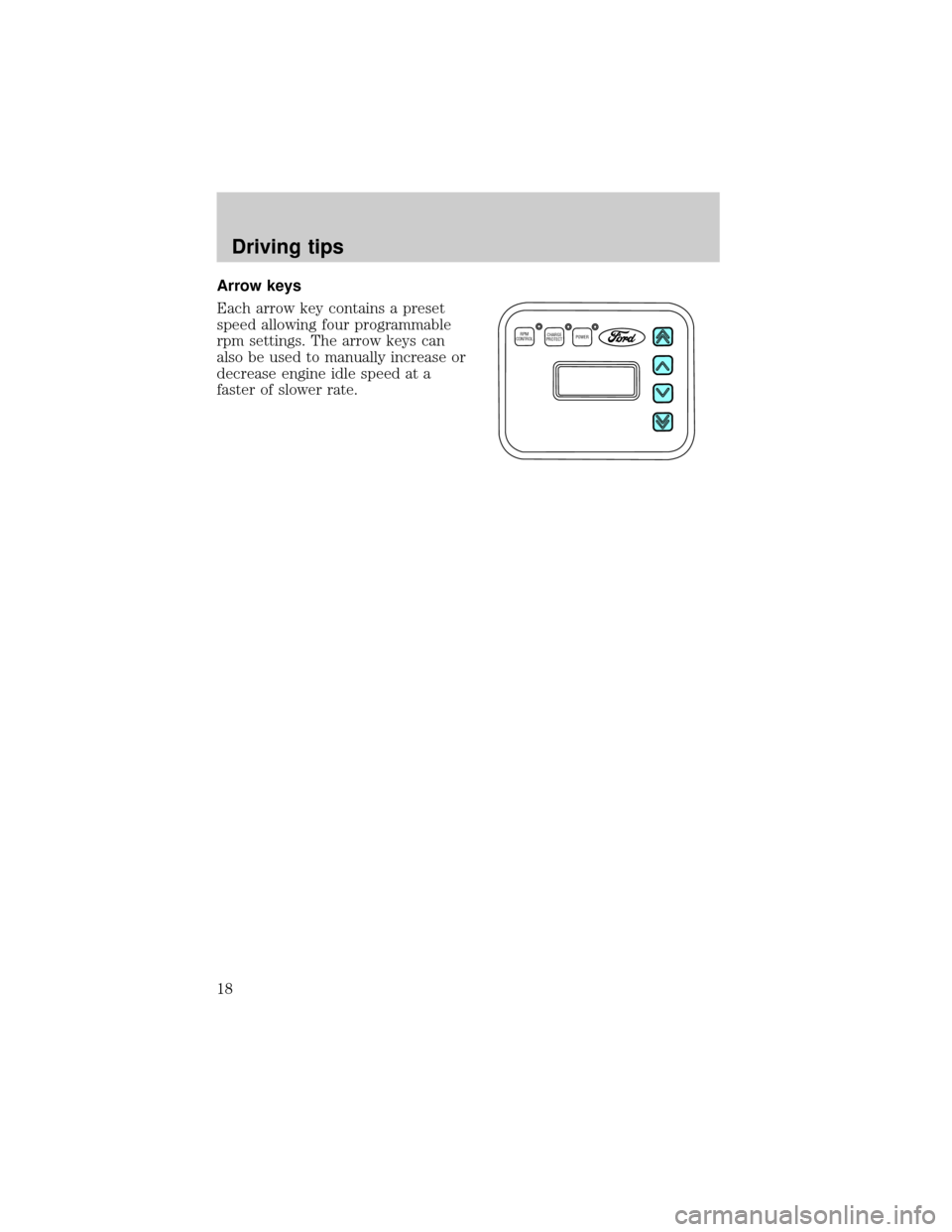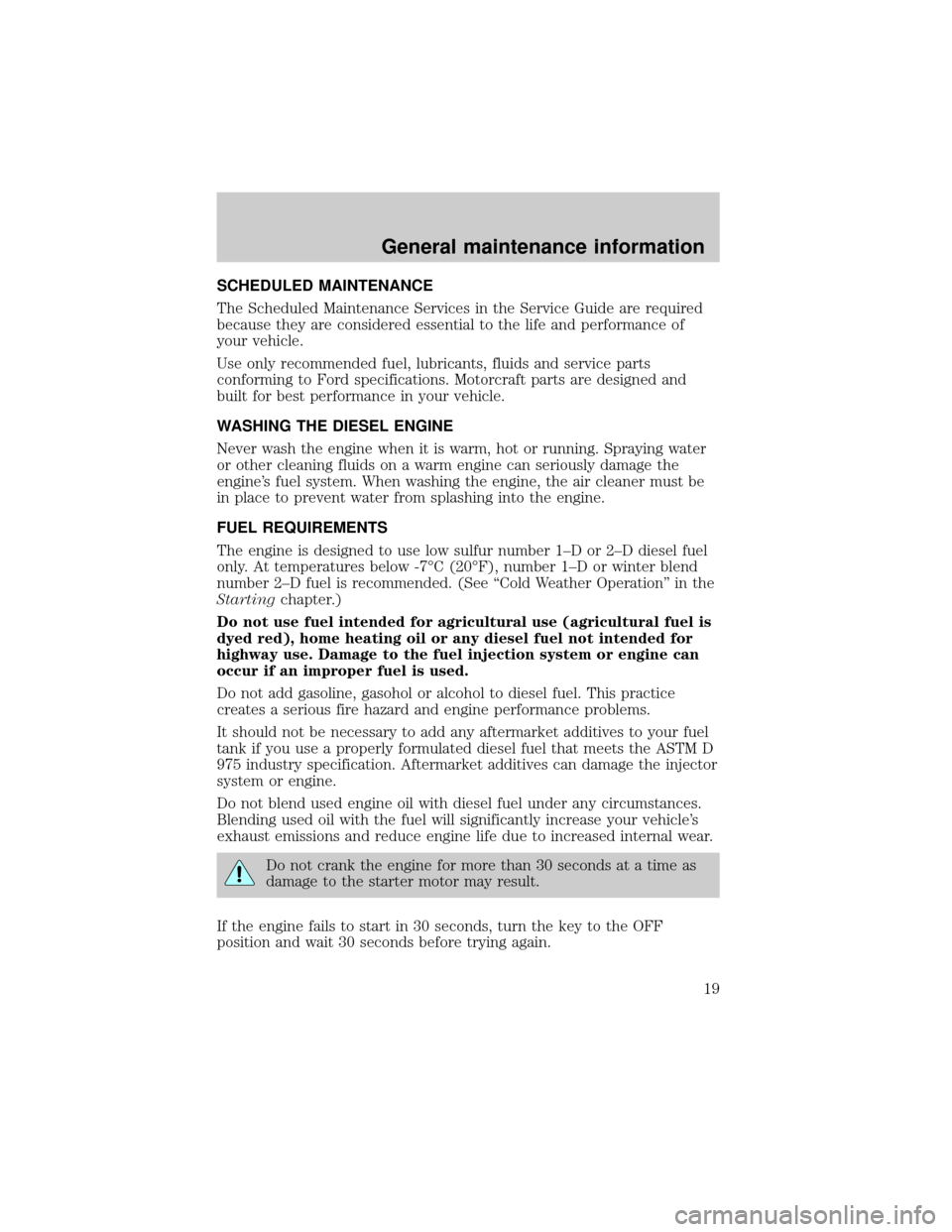key FORD E SERIES 1999 4.G 7.3L Diesel Supplement Manual
[x] Cancel search | Manufacturer: FORD, Model Year: 1999, Model line: E SERIES, Model: FORD E SERIES 1999 4.GPages: 39, PDF Size: 0.46 MB
Page 8 of 39

WAIT TO START
With the key in the ON position, the
WAIT TO START light will illuminate
if glow plug heat is necessary as a
starting aid. Wait until the light goes
off before starting. The light should
always illuminate briefly, when the ignition key is in the ON position. If
the light does not illuminate, there may be a problem. Refer to the
Startingchapter in this guide. After the engine starts, the light should
remain off.
The light should always illuminate at least momentarily when the engine
is cold and the ignition is turned to ON. If it does not illuminate, the
glow plug system should be checked and repaired promptly to avoid
difficulty in cold starting.
WATER IN FUEL
During refueling, it is possible for
water-contaminated diesel fuel to be
pumped into your tank. Your vehicle
fuel system is equipped with a fuel
filter/water separator to remove
water from the fuel. The WATER IN FUEL light will illuminate when the
ignition is turned to START (as part of the light function check) and
when the fuel filter/water separator has a significant quantity of water in
it.
If the light illuminates when the engine is running, stop the vehicle as
soon as safely possible, shut off the engine, then drain the filter bowl.
Refer to theGeneral maintenancechapter for drain procedure.
Allowing water to stay in the system could result in extensive damage to,
or failure of, the fuel injection system.
Do not drain the water separator while the engine is running.
Fuel may ignite if the separator is drained while the engine is
running or the vehicle is moving.
WAIT
TO
START
WATER
IN
FUEL
Warning lights
8
Page 9 of 39

STARTING THE ENGINE
Read all starting instructions carefully before you start your vehicle.
Starting procedures are also shown on the vehicle visor. For
temperatures below 0ÉC (32ÉF), the use of the correct grade engine oil is
essential for proper operation.
If your vehicle is equipped with a manual transmission, make sure the
parking brake is set fully before you turn the key. Depress the clutch
pedal and place the gearshift in the neutral position. The clutch must be
fully depressed in order to operate the starter. Do not press the
accelerator during starting.
If your vehicle is equipped with an automatic transmission, ensure the
gearshift lever is in P (Park) and the parking brake is set before you turn
the key. Do not press the accelerator during starting.
COLD WEATHER STARTING
Do not crank the engine for more than 30 seconds at a time as starter
damage may occur. If the engine fails to start, turn the key to OFF and
wait 30 seconds before trying again.
Do not use starting fluid such as ether in the air intake system (see Air
Cleaner Decal). Such fluid could cause immediate explosive damage to
the engine and possible personal injury.
Do not add gasoline, gasohol or alcohol to diesel fuel. This practice
creates a serious fire hazard and causes engine performance problems.
1. Make sure all vehicle occupants have buckled their safety belts. For
more information on safety belts and their proper usage, refer toSeating
and safety restraintschapter in the owner guide.
2. Make sure the headlamps and vehicle accessories are off.
3. Turn the key to the ON position.
When the WAIT TO START light
goes off, turn the key to START.
(For Canadian vehicles, the daytime
running lamps will be on if the
parking brake is not applied and the key is turned to ON.)
4. When the engine starts, release the key. The glow plugs will continue
to be activated for up to two minutes. If the engine is not started before
the activation ceases, the glow plug system must be reset by turning the
ignition key to OFF.
WAIT
TO
START
Starting
9
Page 18 of 39

Arrow keys
Each arrow key contains a preset
speed allowing four programmable
rpm settings. The arrow keys can
also be used to manually increase or
decrease engine idle speed at a
faster of slower rate.
RPM
CONTROLCHARGE
PROTECTPOWER
Driving tips
18
Page 19 of 39

SCHEDULED MAINTENANCE
The Scheduled Maintenance Services in the Service Guide are required
because they are considered essential to the life and performance of
your vehicle.
Use only recommended fuel, lubricants, fluids and service parts
conforming to Ford specifications. Motorcraft parts are designed and
built for best performance in your vehicle.
WASHING THE DIESEL ENGINE
Never wash the engine when it is warm, hot or running. Spraying water
or other cleaning fluids on a warm engine can seriously damage the
engine's fuel system. When washing the engine, the air cleaner must be
in place to prevent water from splashing into the engine.
FUEL REQUIREMENTS
The engine is designed to use low sulfur number 1±D or 2±D diesel fuel
only. At temperatures below -7ÉC (20ÉF), number 1±D or winter blend
number 2±D fuel is recommended. (See ªCold Weather Operationº in the
Startingchapter.)
Do not use fuel intended for agricultural use (agricultural fuel is
dyed red), home heating oil or any diesel fuel not intended for
highway use. Damage to the fuel injection system or engine can
occur if an improper fuel is used.
Do not add gasoline, gasohol or alcohol to diesel fuel. This practice
creates a serious fire hazard and engine performance problems.
It should not be necessary to add any aftermarket additives to your fuel
tank if you use a properly formulated diesel fuel that meets the ASTM D
975 industry specification. Aftermarket additives can damage the injector
system or engine.
Do not blend used engine oil with diesel fuel under any circumstances.
Blending used oil with the fuel will significantly increase your vehicle's
exhaust emissions and reduce engine life due to increased internal wear.
Do not crank the engine for more than 30 seconds at a time as
damage to the starter motor may result.
If the engine fails to start in 30 seconds, turn the key to the OFF
position and wait 30 seconds before trying again.
General maintenance information
19
Page 34 of 39

IF THE ENGINE WON'T CRANK
Turn on the headlights. If the lights are dim, do not go on at all or if
when the ignition is turned to START the lights become dim or go out,
the battery connections may be loose or corroded, or the battery may be
discharged. If there is a clicking or stuttering sound coming from the
engine compartment when you turn the key to START, this may also
indicate a loose or corroded battery connection.
Check the battery connections at the battery posts, cable connection to
the engine grounding point and at the starter relay terminals. Also, make
sure the relay bracket is securely fastened to its mounting surface.
If the starter relay clicks, but the starter does not crank, check the
connections at the starter terminal. If a discharged battery is suspected,
have it checked and corrected.
²For vehicles with manual transmissions, the clutch pedalmustbe fully
depressed in order for the starter to operate.
²For vehicles with automatic transmissions, the gearshift lever must be
in Park or Neutral in order for the starter to operate.
²Try operating the starter switch several times. Should the switch be
corroded, this operation may clean the contacts or make the switch
temporarily operable until you can reach the dealer.
²If all electrical connections are tight and you need assistance to start,
see ªJump Starting Your Vehicleº in theStartingchapter.
IF ENGINE CRANKS BUT WON'T START
Prolonged starter cranking (in excess of 30 seconds) could cause
damage to the starter motor.
²Check the fuel gauge. You may be out of fuel. If the gauge shows that
there is fuel in the tank, the trouble may be in the electrical system or
the fuel system. If equipped with an auxiliary tank, be sure that the
tank control switch is set for the tank with fuel and not on an empty
tank.
²Leaving the ignition key ON for over two minutes without starting may
make starting difficult because the glow plugs will cease activation.
Reset the system by turning the ignition key to OFF and then back to
ON again.
Minor troubleshooting guide
34